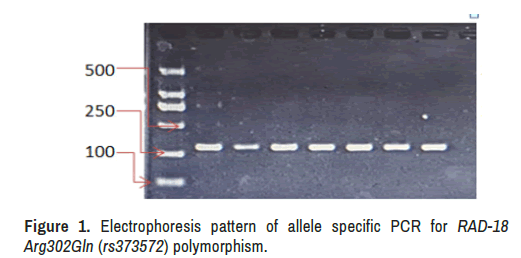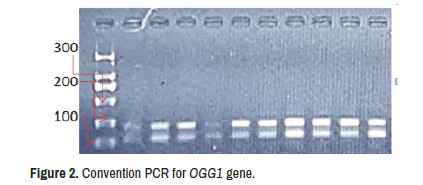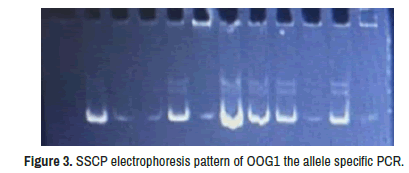Research - Clinical Schizophrenia & Related Psychoses ( 2021) Volume 0, Issue 0
The Rad18 Arg302Gln Rs373572 And Ogg1 Ser326Cys Rs1052133 Genes Polymorphisms In Systemic Lupus Erythematous Disease
Noora M. Hameed1*, Sawsam Jassim Al-Harbi2, Hadeel Alaa Al-Rrubaei3 and Mona N. Al-Terehi42Departmnent of Anatomy, University of Babylon College of Medicine, Babylon, Iraq
3Department of Clinical Biochemistry, University of Babylon College of Medicine, Babylon, Iraq
4Department of Biology, University of Babylon College of Medicine, Babylon, Iraq
Noora M. Hameed, Department of Anesthesia Technique, Al-Nisour University College, Baghdad, Iraq, Email: Noora.anesth@nuc.edu.iq
Received: 19-Jul-2021 Accepted Date: Aug 02, 2021 ; Published: 09-Aug-2021
Abstract
The Systemic Lupus Erythematous (SLE) disease is an autoimmune disease incidence by different genetic and environment factors, the present research study two DNA repair genes polymorphisms in SLE disease included RAD-18 Arg302Gln (rs373572) and OGG1 Ser326Cys (rs1052133) genes, the polymorphisms were detection using allele specific PCR and PCR-SSCP, patients were diagnostic by specialist physician then DNA was isolated from whole blood, the results show that The RAD-18 gene variation show non-significant differences between patients and control, tow genotyping (AA and AG) were observed and GG didn’t observed, the distribution of AA and AG were 95.29% of patients have AA while 92.85% in control GG appeared in 4.76% of patients and 7.14% in control (OR 0.6667, P value 0.6936). The OGG1 Ser326Cys (rs1052133) genes polymorphisms shows there haplotypes A, B, and C represented by four pattern ABC, AC, A and C. AC (47.5%), C (30%) and A (12.5%) were more frequent in patients than control in significant level for AC (OR 8.1429, P 0.0006) and non- significant level for C (OR 5.029, P 0.0574) and A (OR 0.1196, P 0.167). the present finding concluded that SLE association with OGG1, and don’t related with RAD-18.
Keywords
Chronic autoimmune diseases • Systemic Lupus Erythematous • DNA • Genotyping
Introduction
The Systemic Lupus Erythematous also called as lupus or (SLE) is one of the chronic autoimmune diseases its recorded in a high incidence rate at the last decades its about 5 million cases in the world, The diagnosis of SLE dependent on the 11 diagnostic clinical criteria dependent by the college of rheumatology including native DNA antibodies [1]. The incidence percentages were recorded in female at nine fold higher than male and 2-3 fold higher in Asian African and native American ancestry than other population [2,3], the genome wide association found more than 50 risk alleles contributed in the SLE pathogenicity and major of them associated with immune system response in addition to the other genetic predisposition factors [4-6].
The association between SLE and DNA repair system come from the un ability of cells to repair DNA lesions, different types of DNA repair systems genes polymorphisms have been reported to be associated with SLE such as DNA glycosylase for repair Sp and Gh encoded by NEIL3 [7]. Scaffold protein encoded by XRCC1 [8], DNA glycosylase encoded by OGG1 [9]. In addition to POLB that DNA gaps filled through BER; work in SHM and VDJ recombination [10-12], all these genes encoded to proteins involved in base excision repair, any mutation in genes that encoded to proteins contributed in repair activity may be associated with SLE development. Mutations in any one of these genes may be associated with increased risk for lupus development because of the abnormal in DNA repair led to generation antibody diversification, apoptosis, elevation the abnormal in DNA processing which resulted to autoantibodies generation [13].
Materials and Methods
A case control study conducted in DNA lab/university of Babylon included 45 SLE patients were attended to the chronic disease clinic in Marjan hospital city, all patients were detected by Dr. Ali Al-kazaz, and samples were collected according to ethical approval of environment and health ministry of Iraq. DNA was extracted from frozen blood, and then its concentration and purity were detected. Electrophoresis samples were implemented using agaros gel and PCR for RAD18 and OGG1 were detected via the following primers, RAD18 by allele specific PCR F1- ATA CCC ATC ACC CAT CTT C, R1- GTC TTC TCT ATA TTT TCG ATT TCT T, F2- TTA ACA GCT GCT GAA ATA GTT CG, R2- CTG AAA TAG CCC ATT AAC ATA CA. 3’for the A allele producing a 146 bp band, 106 bp of G allele, 206 bp was amplified using the F1 and the R2, at the annealing TM 58°C. OGG1 Ser326Cys F- GGTGGCCCTAAAGGACTCTC, R-AAGGTGCTTGGGGAATTTCT, the PCR product was 295 bp, then haplotypes were implemented by SSCP technique according to [14,15]. The data analysis using Odd ratio at CI 95% p value less than 0.05.
Results and Discussion
The present study aims to investigated the RAD-18 Arg302Gln (rs373572) and OGG1 Ser326Cys (rs1052133) genes polymorphism in SLE patients, results show that the patients age mean was (31.34 ± 9.25) and disease duration was (9.20 ± 5.99) while the control age mean was (33.10 ± 11.38), all clinical features of SLE diagnosis criteria were detected in the hospital center of chronic diseases. The incidences of SLE have been increased in last years and the relation of DNA repair systems with SLE development still under investigations.
The RAD-18 gene variation show non-significant differences between patients and control, tow genotyping (AA and AG) were observed and GG didn’t appeared in present study, the distribution of AA and AG explained in Table 1.
| Genotyping | Patients | Control | Odd ratio | P value |
|---|---|---|---|---|
| AA | -(95.29%) | -(92.85%) | 0.6667 | 0.6936 |
| AG | -(4.76%) | -(7.14%) | 0.0887 to 5.0130 | |
| G | 0.522 | 0.533 | 1.0452 | 0.6221 |
| A | 0.477 | 0.466 | 0.8768 to 1.2459 |
Table 1: The RAD-18 Arg302Gln polymorphism (rs373572) in SLE patients and control groups. able 1. The RAD-18 Arg302Gln polymorphism (rs373572) in SLE patients and control groups.
95.29% of patients have AA while in control 92.85% GG appeared in 4.76% of patients and 7.14% in control (OR 0.6667, P value 0.6936) (Figure 1).
Electrophoresis pattern of allele specific PCR for RAD-18 Arg302Gln (rs373572) polymorphism and convention PCR for OGG1 gene. OGG1 gene have 295 bp for SLE patients and control SSCP electrophoresis pattern of OOG1 the allele specific PCR, 146 bp for G allele and 106 bp for A allele for SLE patients and control (Figures 2 and 3). The values are (agaros gel electrophoresis via 70 V, 20 mA, 0.5 × of TBE for 40 min), (40% polyacrylamide gel, 1 × sscp loading stain, 100 V, 50 min and 0.5 × TBE), three haplotypes A, B and C were detection.
The RAD-18 is gene located at 3p25.3 and encoded to an E3 ubiquitinprotein ligase, it's had an important role in the repair of DNA lesions in DNA post replication, the mutation in this gene lead to accumulation of UV DNA damage and more sensitive to mutagens factors [16,17], the RAD-18 gene polymorphism have been found that it has associated with different disease like cancer and diabetes mellitus [18]. But, the literature review about SLE association with RAD-18 gene polymorphism were didn’t recorded, this study proved that there was no association between Arg302Gln (rs373572) of RAD-18 gene and SLE disease.
The OGG1 Ser326Cys (rs1052133) genes polymorphisms was studied in present study via SSCP technique, there haplotypes were observed A, B, and C represented by four pattern ABC, AC, A and C. the present results show that AC (47.5%), C (30%) and A (12.5%) were more frequent in patients than control in significant level for AC (OR 8.1429, P 0.0006) and non- significant level for C (OR 5.029, P 0.0574) and A (OR 0.1196, P 0.167). The present study shows association between OGG1 Haplotypes and SLE disease (Table 2).
| Genotyping | Patients | Control | Odd ratio | P value |
|---|---|---|---|---|
| ABC | -(10%) | -(63.33%) | 8.1429 | 0.0006 |
| AC | -(47.5%) | -(6.66%) | 2.4401 to 27.1731 | |
| C | -(30%) | -(30.0%) | 5.0294 0.9505 to 26.6125 |
0.0574 |
| A | -(12.5) | 0 | 0.1196 0.0059 to 2.4402 |
0.1675 |
Table 2: The haplotype polymorphisms of OGG1 Ser326Cys (rs1052133) genes polymorphisms gene in study groups.
The OGG1 is gene encoded to DNA glycosylase, bi-functional enzyme excises 8-oxoguanine induced by ROS [19], the mutations in OGG1 have been reported and several SNPs were associated with different disease as well as rs1052133 which found associated with SLE nephritis development and with elevation 8-oxoguanine in patients plasma which deal with present study findings, the polymorphism in OGG1 gene was suggested by elevation or lowering in enzyme activity like in homozygous of 1245 CC genotype which has higher enzyme activity [20]. Then the 1245 CG genotype and the homozygous 1245 GG genotype show lower activity than previous genotyping [21]. The activity of OGG1 enzyme was detected by the level of 8-OHDG and this may be elevation in SLE patients which was affected by different factors like lifestyle, psychological health and types of therapies [22], the OGG1 gene polymorphism were associated with some disease like diabetes mellitus [23], Huntington’s disease and some types of cancer [24,25]. However the OGG1 role in SLE pathogenesis didn’t fully understand, on the other hand Lee concluded that the OGG1 genotyping is one factors of SLE nephritis via C1245G polymorphism [26]. The level of DNA damage should be detected in individuals as a prognostic preliminary for avoid the prospective harmful effects which may be contributed in the development disease like SLE.
Conclusion
The present study concluded that the RAD-18 Arg302Gln (rs373572) didn’t associated with SLE while OGG1 Ser326Cys (rs1052133) associated with disease in significant differences. The incidence percentages were recorded in female at nine fold higher than male and 2-3 fold higher in Asian African and Native American Ancestry than other population, the genome wide association found more than 50 risk alleles contributed in the SLE pathogenicity and major of them associated with immune system response in addition to the other genetic predisposition factors. The Systemic Lupus Erythematous (SLE) disease is an autoimmune disease incidence by different genetic and environment factors, the present research study two DNA repair genes polymorphisms in SLE disease included RAD-18 Arg302Gln (rs373572) and OGG1 Ser326Cys (rs1052133) genes, the polymorphisms were detection using allele specific PCR and PCR-SSCP, patients were diagnostic by specialist physician then DNA was isolated from whole blood, the results show that The RAD-18 gene variation show nonsignificant differences between patients and control. The RAD-18 is gene located at 3p25.3 and encoded to an E3 ubiquitin-protein ligase, it's had an important role in the repair of DNA lesions in DNA post replication.
References
- Petri, Michelle, Ana-Maria Orbai, Graciela S Alarcón and Caroline Gordon, et al. “Derivation and Validation of the Systemic Lupus International Collaborating Clinics Classification Criteria for Systemic Lupus Erythematosus.” Arthritis Rheum 64 (2012): 2677-86
- Petri, Michelle. “Sex Hormones and Systemic Lupus Erythematosus.” Lupus 17 (2008): 412-5.
- Tedeschi, Sara K., Bonnie Bermas and Karen H. Costenbader. "Sexual Disparities in the Incidence and Course of SLE and RA." Clin Immunol 149 (2013): 211-218.
- Alarcónâ?Segovia, Donato, Marta E. Alarcónâ?Riquelme, Mario H. Cardiel and Francisco Caeiro, et al. "Familial Aggregation of Systemic Lupus Erythematosus, Rheumatoid Arthritis, and Other Autoimmune Diseases in 1,177 Lupus Patients from the GLADEL Cohort." Arthritis Rheum 52 (2005): 1138-1147.
- Deafen, Dennis, Agustin Escalante, Lisa Weinrib, David Horwitz, et al. "A Revised Estimate of Twin Concordance in Systemic Lupus Erythematosus." Arthritis & Rheum 35 (1992): 311-318.
- Ghodke-Puranik, Yogita, and Timothy B. Niewold. "Immunogenetics of Systemic Lupus Erythematosus: A Comprehensive Review." J Autoimmun 64 (2015): 125-136.
- Massaad, Michel J, Jia Zhou, Daisuke Tsuchimoto and Janet Chou, et al. “Deficiency of Base Excision Repair Enzyme NEIL3 Drives Increased Predisposition to Autoimmunity.” J Clin Invest 126 (2016): 4219-4236.
- Lin, Yu-Ju, L. Wan, C. M. Huang and S. Y. Chen, et al. "Polymorphisms in the DNA Repair Gene XRCC1 and Associations with Systemic Lupus Erythematosus Risk in the Taiwanese Han Chinese Population." Lupus 18 (2009): 1246-1251.
- Lee, Hui-Ting, Chen-Sung Lin, Chyou-Shen Lee and Chang-Youh Tsai, et al. "The Role of hOGG1 C1245G Polymorphism in the Susceptibility to Lupus Nephritis and Modulation of the Plasma 8-OHdG in Patients with Systemic Lupus Erythematosus." Int J Mol Sci 16 (2015): 3757-3768.
- Han, Jian-Wen, Hou-Feng Zheng, Yong Cui and Liang-Dan Sun, et al. "Genome-Wide Association Study in a Chinese Han Population Identifies Nine New Susceptibility Loci for Systemic Lupus Erythematosus." Nat Genet 41 (2009): 1234-1237.
- Sheng, Yu-Jun, Jin-Ping Gao, Jian Li and Jian-Wen Han, et al. "Follow-up Study Identifies Two Novel Susceptibility Loci PRKCB and 8p11. 21 for Systemic Lupus Erythematosus." Rheumatology (Oxford) 50 (2011): 682-688.
- Senejani, Alireza G., Yanfeng Liu, Dawit Kidane, Stephen E. Maher, et al. "Mutation of POLB Causes Lupus in Mice." Cell Rep 6 (2014): 1-8.
- Meas, Rithy, Matthew J. Burak, and Joann B. Sweasy. "DNA Repair and Systemic Lupus Erythematosus." DNA Repair (Amst) 56 (2017): 174-182.
- Al-Terehi, Mona, Aizhar Hamzih Hasan, Methak, AL-Jboory J and Ali H. Al-Saadi, et al. “Haplotype Polymorphisms in Cytokines Genes Using Pcr-Sscp Technique in Iraqi Breast Cancer Patients.” Der Pharma Chemica 8 (2016): 27-31.
- Alriyahee, Fulla Abd Alsattar, Noora M. Hameed, Israa Harjan Mohsen, and Mona N. Al-Terehi. "Potential Impact of Micro RNA-146a Gene Polymorphisms in Oxidative Stress of Diabetic Mellitus Type." Systematic Reviews in Pharmacy 11 (2020): 260-263.
- Tateishi, Satoshi, Yoshiyuki Sakuraba, Sadaharu Masuyama and Hirokazu Inoue, et al. "Dysfunction of Human Rad18 Results in Defective Postreplication Repair and Hypersensitivity to Multiple Mutagens." Proc Natl Acad Sci USA 97 (2000): 7927-7932.
- Xin, Hua, Wensheng Lin, Wasana Sumanasekera and Yanbin Zhang, et al. "The Human RAD18 Gene Product Interacts with HHR6A and HHR6B." Nucleic Acids Res 28 (2000): 2847-2854.
- Kanzaki, Hirotaka, Mamoru Ouchida, Hiroko Hanafusa, Hiromasa Yamamoto, et al. "The Association Between RAD18 Arg302Gln Polymorphism and the Risk of Human Non-Small-Cell Lung Cancer." J Cancer Res Clin Oncol 134 (2008): 211-217.
- Boiteux, Serge, and J. Pablo Radicella. "The Human OGG1 Gene: Structure, Functions, and its Implication in the Process of Carcinogenesis." Arch Biochem Biophys 377 (2000): 1-8.
- Lee, Hâ?T., Câ?S. Lin, Câ?S. Lee and Câ?Y. Tsai, et al. "Increased 8â?Hydroxyâ?2′â?Deoxyguanosine in Plasma and Decreased mRNA Expression of Human 8â?Oxoguanine DNA Glycosylase 1, Antiâ?Oxidant Enzymes, Mitochondrial Biogenesisâ?Related Proteins and Glycolytic Enzymes in Leucocytes in Patients with Systemic Lupus Erythematosus." Clin Exp Immunol 176 (2014): 66-77.
- Kohno, Takashi, Kazuya Shinmura, Masahiko Tosaka and Masachika Tani, et al. "Genetic Polymorphisms and Alternative Splicing of the hOGG1 Gene, that is Involved in the Repair of 8-Hydroxyguanine in Damaged DNA." Oncogene 16 (1998): 3219-3225.
- Chen, Shin-Kuang, Wanhua Annie Hsieh, Mong-Hsun Tsai and Chien-Chih Chen, et al. "Age-Associated Decrease of Oxidative Repair Enzymes, Human 8-Oxoguanine DNA Glycosylases (hOgg1), in Human Aging." J Radiat Res 44 (2003): 31-35.
- Sun, Caixia, Xiufang Liu, Huan Zhang and Wenwen Guo, et al. “Functional Polymorphism of hOGG1 Gene is Associated with Type 2 Diabetes Mellitus in Chinese Population.” Mol Cell Endocrinol 325 (2010): 128-134.
- Coppedè, Fabio, Francesca Migheli, Roberto Ceravolo and Elisa Bregant, et al. "The hOGG1 Ser326Cys Polymorphism and Huntington's Disease." Toxicology 278 (2010): 199-203.
- Lin, Chen-Sung, Liang-Shun Wang, Teh-Ying Chou and Wen-Hu Hsu, et al. "Cigarette Smoking and hOGG1 Ser326Cys Polymorphism are Associated with 8-OHdG Accumulation on Mitochondrial DNA in Thoracic Esophageal Squamous Cell Carcinoma." Ann Surgical Oncol 20 (2013): 379-388.
- Lee, Hui-Ting, Chen-Sung Lin, Chyou-Shen Lee and Chang-Youh Tsai, et al. "The Role of hOGG1 C1245G Polymorphism in the Susceptibility to Lupus Nephritis and Modulation of the Plasma 8-OHdG in Patients with Systemic Lupus Erythematosus." Int J Mol Sci 16 (2015): 3757-3768.
Citation: Hameed, Noora M., Sawsam Jassim Al-Harbi, Hadeel Alaa Al-Rrubaei and Mona N. Al-Terehi. "The RAD-18 Arg302Gln (rs373572) and OGG1 Ser326Cys (rs1052133) Genes Polymorphisms in Systemic Lupus Erythematous Disease." Clin Schizophr Relat Psychoses 15S(2021). Doi: 10.3371/CSRP.HNSA.080921.
Copyright: © 2021 Hameed NM, et al. This is an open-access article distributed under the terms of the creative commons attribution license which permits unrestricted use, distribution and reproduction in any medium, provided the original author and source are credited. This is an open access article distributed under the terms of the Creative Commons Attribution License, which permits unrestricted use, distribution, and reproduction in any medium, provided the original work is properly cited.









